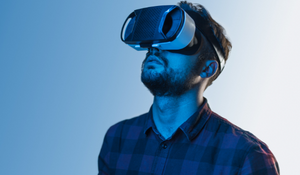As technology continues to push forwards faster than ever before, new technologies are sprouting up left and right. Two of these that seem to be hitting mainstream media more frequently are ‘AR’ and ‘VR’, but what exactly are they?

The simplest explanation is to expand the acronyms out which gives us ‘Augmented Reality’ and ‘Virtual Reality’. Huh.. That didn’t seem to help too much did it? Okay, let’s break it down!
Augmented Reality, looking at what these words mean individually we are ‘improving’ reality and the dictionary defines ‘augment' as “[to] make (something) greater by adding to it; increase.”. From a technological standpoint this isn’t strictly correct, but it’s pretty darn close! Obviously, we cannot just add some code into the world and start adding cool things to a street, but what we can do is use our devices to do so.
In the simplest example, using a smartphone’s camera, we can start to grab information about someone’s surroundings and mix it with local data to perhaps ‘overlay’ some information onto the street you’re walking down. You’d have to be looking through your smartphone and pointing it in the right direction, but there’s been a lot of experimental devices that look to give you this sort of experience in a handsfree way. Google attempted this with ‘Google Glass’, and Bose has spun a slightly different angle on it with their ‘Audio AR’ which intends to give you information about your surrounding areas whilst you are there.
From viewing furniture in your house and virtually re-painting a wall, to games that have racetracks around your living room; AR can deliver both useful and fun applications to your users.
-png.png)
Virtual Reality on the other hand is a whole different ballgame. Rather than working with our existing world, which let’s be honest is a little boring at times, we can instead take users and put them into a completely customised world of creative freedom. At the click of a button you can transport your users from their office and on to the top of the Himalayas, throw them headfirst into a space-age supercity, or even shrink them down to the microscopic level to explore the body from the viewpoint of a red blood cell.
This is the field that excites me the most. It’s in continuous development, and we’ve only scratched the surface with what its applications could be. As the technology around VR expands more and more our ways of interacting with the virtual world grows with it. Think of the original Playstation VR with the ‘wands’ that you’d have, basically an orb light on a stick that allowed you to move your hands around and pull a trigger to interact with something. And nowadays people are experimenting with gloves that allow you to use your individual fingers and even physically resist your fingers to simulate the sensation of touch!
People are already on the path to create levels of immersion that aren’t far away from what you see in the movie “Ready Player One”. With VR treadmills currently available in the real world, simulated feedback gloves, full body suits that can directly track your movements without needing an array of cameras; we’d go so far as to say we’re not that far off at all.